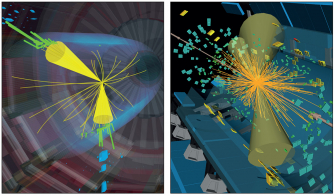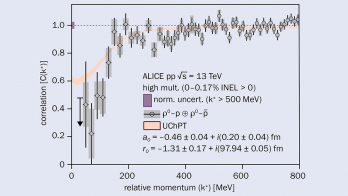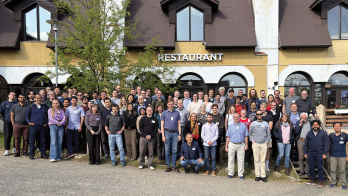
The CMS experiment at CERN recently published first measurements of the cross-section for top-antitop pair production at a centre-of-mass energy of 7 TeV. The top quark is the heaviest known fundamental particle, with a mass of about 172 GeV, almost 185 times that of the proton. Until recently the production of top quarks was the privilege of the Tevatron at Fermilab.
Top quarks decay instantly and almost exclusively into a heavy W boson and a bottom quark (b). The b quark then “hadronizes” into a jet of particles, which can often be distinguished from a jet originating from a lighter quark or gluon by the presence of a secondary vertex in the event. The W boson can decay into either two jets or two leptons. The recent CMS analysis relies on the W bosons from both of the top quarks decaying into two leptons, i.e. either to a muon plus a neutrino, or into an electron plus a neutrino. This leads to a signature for top-antitop (tt) consisting of two b-quark jets, two charged leptons and two neutrinos. The neutrinos will pass through the detector without leaving any trace but their presence can be induced from the missing (transverse) energy in the collision.
Such a signature is very distinct and relatively free of background. The CMS collaboration performed this first analysis on a sample of data taken in the first few months of LHC operation at 7 TeV, corresponding to an integrated luminosity of around 3 pb–1. They identified 11 candidate events and calculated the number of jets per event thought to originate from bottom quarks, as shown in the figure, which also indicates the expectations for signal and background. The latter is indeed very small. The analysis of this event sample yields a top cross section of 194 ± 72 (stat.) ± 24 (syst.) ± 21 (lumi). Within the measurement uncertainties, this value for the cross-section is in good agreement with calculations in higher-order perturbative QCD.
While the top quark is an interesting object to study in itself, it will also play an important role as background in searches for new physics. Therefore an early measurement of its cross-section at this new centre-of-mass energy is an important step towards exploring the unknown.
Further reading
CMS collaboration 2010 arXiv:1010.5994 [hep-ex]. Submitted to Phys. Lett. B.








